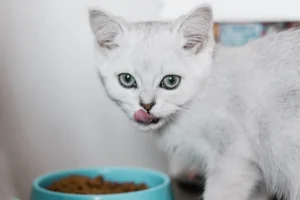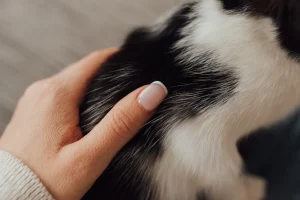Cats are known for their soft and luxurious fur, so it can be quite surprising to feel a crinkly texture when petting your feline friend. If you’ve noticed this peculiar sensation, you might be wondering: why does my cat feel crinkly?
When your cat feels crinkly to the touch, it could be due to a variety of reasons. Let’s explore some of the common causes and what you can do to help your cat feel their best.
Lack of Grooming
Does your cat feel crinkly to the touch? One potential reason could be a lack of grooming. Cats are known for their meticulous grooming habits, but sometimes they may slack off, especially as they age or if they are feeling unwell. When cats don’t groom themselves regularly, their fur can become matted and tangled, leading to that crinkly texture you may be feeling.
To help your cat maintain a healthy coat, brush them regularly to remove any tangles or mats. Provide a balanced diet with essential nutrients to support their coat health. You can also schedule regular grooming sessions with a professional groomer to keep their fur in top condition.
Skin Issues
If your cat’s fur feels crinkly, it might be a sign of underlying skin issues. Dry skin can cause your cat’s coat to become brittle and crinkly. Make sure your cat is properly hydrated and consider adding Omega-3 fatty acids to their diet to improve skin health.
Parasites, such as fleas or mites, can also contribute to your cat’s crinkly fur. Check your cat for any signs of parasites and consult your veterinarian for appropriate treatment. Additionally, regular flea prevention is essential to keep your cat’s skin and coat healthy.
Remember, your cat’s well-being is reflected in their fur, so paying attention to grooming and skin health can help them feel their best!
(Additional unique insight: Regularly cleaning your cat’s bedding and environment can also help prevent skin issues that may lead to a crinkly coat.)
Diet and Hydration
Maintaining a balanced diet and ensuring proper hydration for your feline friend are crucial elements in keeping their coat healthy and smooth. If your cat’s fur feels crinkly, it could be a sign of nutritional deficiencies or dehydration. Make sure your cat is receiving a high-quality diet that meets their specific needs, and always provide access to fresh water. Omega-3 fatty acids found in fish oil supplements can also help improve your cat’s coat texture and overall skin health. Remember, what your cat eats and drinks directly impacts the condition of their fur!
Environmental Factors
Don’t overlook the impact of environmental factors on your cat’s fur texture. High humidity levels can make your cat’s coat feel damp and unkempt, while exposure to certain materials like rough fabrics or chemicals can cause their fur to become rough or crinkly. To combat these effects, ensure your home is well ventilated and maintain optimal humidity levels. Providing your cat with a soft and comfortable resting area can also help prevent any rough materials from affecting their coat. Lastly, regular grooming can help remove any external factors that may be contributing to your cat’s crinkly fur. Pay attention to your cat’s surroundings and make necessary adjustments to keep their coat looking and feeling its best.
Stress and Anxiety
Have you noticed your cat feeling crinkly lately? It could be a sign of stress or anxiety. Cats, just like humans, can physically express their mental well-being through their fur texture. If your furry friend is experiencing stress, it may affect the quality of their coat, making it appear dull or crinkly. To help reduce your cat’s stress levels, create a calm environment with plenty of hiding spots, provide interactive toys for mental stimulation, and establish a routine that includes regular playtime and feeding schedules. Additionally, consider using pheromone diffusers or calming treats to help your cat relax.
Regular Vet Check-ups
Regular vet check-ups are crucial in identifying any underlying health issues that may be causing your cat to feel crinkly. Although stress and anxiety are common causes of changes in fur texture, it’s essential to rule out any medical conditions. During a vet visit, your cat will receive a thorough physical examination, allowing the vet to check for any skin problems, nutritional deficiencies, or hormonal imbalances that could be affecting their coat. By addressing any health issues early on, you can ensure your cat’s well-being and prevent any further discomfort.
Additional Insight:
- Dietary Imbalance: A lack of essential nutrients in your cat’s diet can also lead to changes in fur texture. Make sure your cat is receiving a balanced diet with high-quality protein and essential fatty acids to support healthy skin and coat. Consult your vet for recommendations on the best diet for your furry friend’s needs.
Remember, a happy and healthy cat will have a shiny and soft coat, so pay attention to any changes in fur texture and consult your vet if you have concerns.
Grooming Tips
Taking proper care of your cat’s fur is essential in keeping it soft and silky. Regular grooming not only helps prevent tangles and knots but also promotes healthy skin and a shiny coat. Brushing your cat regularly can help distribute natural oils, making their fur feel smoother to the touch. Remember to use a cat-specific brush to avoid irritating their skin.
In addition to grooming, providing a balanced diet rich in essential nutrients like omega-3 fatty acids can also improve the texture of your cat’s fur. Foods high in quality protein can contribute to a healthy coat, reducing the chances of it feeling crinkly. Ensure your furry friend stays hydrated, as dehydration can lead to dry, brittle fur.
Regular visits to the vet are crucial to identify any underlying health issues that may be causing your cat’s fur to feel crinkly. Conditions such as allergies, parasites, or hormonal imbalances can affect the quality of their coat. Your vet can recommend suitable treatments to address these issues and restore your cat’s fur to its natural softness.
Remember, a happy and healthy cat is more likely to have soft, silky fur. Spend quality time with your feline friend, provide them with enriching toys and activities, and create a peaceful environment for them to thrive. By prioritizing your cat’s well-being, you can help them maintain a luxurious coat that feels smooth and velvety to the touch.
For more in-depth information on grooming tips for your cat, you can check out this comprehensive guide on Cat Grooming: Cat Grooming Guide
Alex, a passionate animal lover, has experience in training and understanding animal behavior. As a proud pet parent to two dogs and three cats, he founded AnimalReport.net to share insights from animal experts and expand his knowledge of the animal kingdom.









